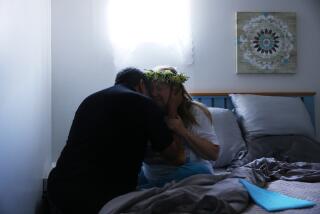Medicineâs Best Only Delayed the Inevitable
Tethered to a spider web of lines to keep her alive, Shari Downs was beginning her 10th hospital stay in 12 months when her doctor asked the inevitable question.
âShari, if you stop breathing, would you want me to . . . keep you alive on the machine artificially?â Dr. James Lugliani recalled. âHer answer was, âDr. Lugliani, do whatever you have to do to keep me alive.â â
âI had no option,â the pulmonary specialist said. âYou do what the patient wants you to do.â
For the more than six years he had been treating Downs, Lugliani had observed her wishes, supplying her with expensive medications, ordering numerous diagnostic tests, bringing in respiratory therapists and, at various times, admitting her to the intensive care unit at Long Beach Community Hospital.
Died Weeks Later
But in April, 1984, only a few weeks after doctor and patient had their conversation about keeping her alive by artificial means, Shari Downs, 53, died of the emphysema that had been devastating her for the last 10 years.
A smoker âuntil she could no longer hold one,â according to a hospice volunteer who had worked with her, Downs had withered to 81 pounds and looked 20 years beyond her age when death finally occurred.
Throughout her last months, her doctor, family and, most likely, Downs herself had known that there was really no hope. New technology and wonder drugs could not cure her. They could only postpone her death.
Yet Lugliani continued to order the expensive laboratory tests and other diagnostic procedures on the chance he could buy more time for his patient. âYou can have a patient who is end stage. They can live another year or two or three,â Lugliani said. âShe definitely could have had another six months or 18 months.â
Overall, more than $200,000 was spent on health care for Downs during her last year of life, including $60,000 charged for her final 34 days in the hospital. Because she was physically disabled by her illness, Downs had to pay only a small portion of the cost. Medicare picked up almost 80%, with a private insurer covering much of the rest.
Unanswered Questions
For Lugliani, Downsâ death raised questions that he has been unable to answer.
âIs it worth spending $200,000 to keep somebody alive for 352 days, realizing fairly well that weâre not going to make her well?â Lugliani asked. âI donât know whose decision that is, but Iâm not sure itâs mine.
âIf you want to make it (my) decision,â he added, â(I) would have done things differently.â The family had doubts too. They questioned Lugliani and what they heard was not encouraging.
âFor a patient who smokes two or three packs a day, thereâs nothing medical science can do for you except pull you out of the fire when you fall in,â Lugliani said.
Plagued by heart disease, deteriorating bones and recurring kidney problems in addition to her emphysema, Downs was wheelchair-bound through much of her last year and, during her stints at home, without energy enough to leave the hospital bed that sat in her living room. A portable toilet was placed at her bedside, and her constant companion, day and night, was her oxygen tank. Refills of oxygen were delivered weekly.
âI donât see how she lived like that,â her daughter, Teri Jacobsen, said. âI would have wanted it to end a long time ago.â
Increasingly worn out by the effort of breathing, Downs bounced in and out of the hospital.
Sky-High Costs
Most of the time, room charges, medications and respiratory therapy services accounted for the bulk of Downsâ hospital bills. She would be charged $295 for each night in her regular room, $725 for intensive care.
Her two or three doses of Demerol each day, required for severe back pain, were $11 a shot, and each 2-inch-by-2-inch gauze pad she used was $1.50. Oxygen boosted the bill $100 a day, and every breathing exercise added $44 more. Charges for many of the dozens of blood tests ordered each week were $40 to $50 each, and the chest X-rays frequently needed to chart the condition of her lungs cost $70 each.
For every visit he made to Downs in the hospital, Lugliani charged $42 to $55. His bills, which included charges for Downsâ weekly or biweekly visits to his office when she was not hospitalized, averaged more than $1,000 a month.
âIn her situation,â acknowledged Lugliani, âyou were just seeing, darn it, chronic care. . . . Her bills were not atypical of a catastrophic illness.â
Hospitalized for much of February, 1984, and into March, Downs was at home for only a week when her most serious breathing problem yet forced her into the intensive care unit of Long Beach Community Hospital on March 25.
âThe night before,â recalled her daughter, âshe started having the problems . . . huffing and puffing. . . . I started to go get a rag for her because she was perspiring a lot, and she asked me not to leave her. . . . Oh, yes, I could see she was scared.â
Major Setback
Taken to the hospital by ambulance, Downs was hooked to a respirator that would breathe for her. Even though the life-sustaining machinery was needed for only a few days, it was a major setback.
A hospice volunteer, by then a regular visitor, spoke to Downs about signing a living will that would have allowed doctors to let her die.
âShari knew she had the choice,â volunteer Sally Feldman said. âShe had the information and did not want to deal with it. . . . She wanted to live desperately at any cost, including having all the machinery in the world.â
By her last week, a virulent blood infection spread throughout her body. Downsâ lungs and heart valves were spotted with fungus, and her talk turned nonsensical.
By her last morning, blood clots had entered her lungs and that, Lugliani said, was âthe final blow.â Downsâ heart stopped and a cardiologist was called to resuscitate her.
Convinced that she was brain-dead despite the emergency resuscitation, Lugliani refused to put his patient back on a breathing machine.
âThere has to be a time you cut the cord, and at that juncture there was no doubt about it,â he said. âBut you see the expense was not incurred at that juncture but in the 12 months before that, and there is the rub.
âTo save money, when would you have not treated her until that moment?â






